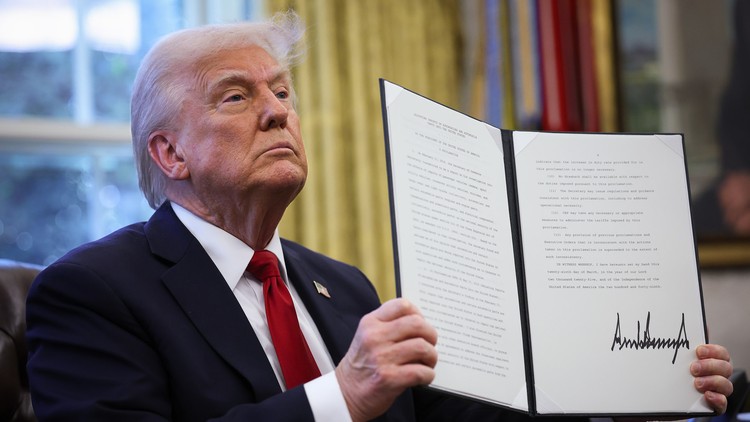
U.S. President Donald Trump displays a signed an executive order in the Oval Office of the White House on March 26, 2025 in Washington, D.C.
Donald Trump signed an executive order March 26 making official the implementation of a 25% tariff on cars and light trucks imported into the United States from other countries, including Canada. If the plans are carried out as declared, the new tax will come into effect in one week’s time, on April 3, which the U.S. president has taken to calling “Liberation Day.”
Those in the know suggest over $200 billion worth of vehicles were imported to America last year. All on its own, General Motors is said to have imported about 750,000 automobiles from Mexico and Canada, including popular midsize crossover models and some proportion of its Chevrolet Silverado and GMC Sierra pickup trucks.
Speaking at a rally in Kitchener, Ontario last night, Prime Minister Mark Carney said the tariffs were a “direct attack” on Canadian autoworkers. “We will defend our workers. We will defend our companies. We will defend our country. And we will defend it together,” he said. Canadian officials have previously discussed retaliatory tariffs to match those levied by the U.S.
Tesla vehicles sit parked on a lot in early March 2025 in Surrey, B.C.
Lana Payne, the president of Unifor, which represents a majority of Canadian auto workers, echoed Carney’s remarks, saying her union will do everything to protect its members. “These are not Donald Trump’s jobs to steal,” she said. “They are not Donald Trump’s jobs to take. They are Canadian jobs.”
There’s a better than decent chance new-vehicle prices will rise overall due to tariffs, on both sides of the border. Stateside, if a Hermosillo, Mexico-made Ford Maverick XLT suddenly has a sticker price of US$46,000 instead of US$39,795, that’s a premium of about $100/mo on a typical 72-month loan. This can be a non-starter for some shoppers trying to stick within a budget. Some economists predict a knock-on effect may even cancel out the supposed benefits of buying local: if a specific trim of the aforementioned Silverado or Sierra jumps from $70,000 to $87,500, it’s possible customers will head for a dealership stocking non-tariffed trucks—which would increase demand and drive up their prices as well.
However, in a confusing statement, U.S. Commerce Secretary Howard Lutnick said automobiles imported under CUSMA (the trade deal penned by Trump in his first term, replacing the North American Free Trade Agreement [NAFTA]) will only be tariffed on the value of content not made in the United States. How the administration plans to determine that accurately is unclear.
We will defend our workers. We will defend our companies. We will defend our country. And we will defend it together.
Let’s look at cars made outside of North America, then. The pert Chevrolet Trax, an affordable crossover that’s far better than its price tag suggests, is Korean-built. The tariffs could hike the sticker price of an LT trim from US$23,995; to almost US$30,000. That’s a death knell for its value proposition, and one fewer affordable vehicle option for U.S. consumers.
We’ll take this opportunity to remind all hands that a 25% levy has been in place since 1964 on pickup trucks made outside of North America. Its implementation directly and immediately curtailed the import of machines like the Volkswagen Bus in its open-bed configuration, plus vehicles from the likes of Toyota and Mazda. It took decades for companies like Toyota to build pickup trucks assembly plants in America, since constructing huge factories isn’t exactly an overnight process.
Over the years, companies have tried (and succeeded) in circumventing the tariff. For a spell, Ford imported its European-built Transit Connect cargo van equipped with seats and windows that classed it a passenger vehicle; the seats were then removed after landing in North American dealerships. Mercedes-Benz Sprinter vans were once shipped from Germany as a so-called “assembly kit,” and then technically hammered together in South Carolina.
It’ll be interesting to see if similar tactic will be attempted this time around, especially since the new tax is applied to a much wider net of vehicles. Think any companies will continue shipping vehicles from South Korea or Japan or Mexico without internal-combustion engines or sans battery packs, then perform “final assembly” in the States? Surely someone, on both the manufacturer and government side, have already thought and acted on that.
Given the wild swings in policy from the White House, these next few weeks and months are uncharted territory.
Sign up for our newsletter Blind-Spot Monitor and follow our social channels on X, Tiktok and LinkedIn to stay up to date on the latest automotive news, reviews, car culture, and vehicle shopping advice.






